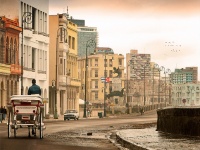 Havana OverviewSituated on the north coast of the island and built around a
natural harbour, Havana (La Habana), is one of the most lively and
colourful cities in the Caribbean. Much of the city's charm can be
found among the narrow, derelict streets packed with crumbling
buildings and fascinating people. Every open door and overhanging
balcony allows glimpses of rocking chairs and colourful washing,
accompanied by the strains of music. On the streets Chinese-made
bicycles, yellow, egg-shaped coco-taxis and two-humped camello
(camel) buses weave among the melee of 1950s Chevy's and Russian
Ladas. The historic old town, Habana Vieja or Colonial Havana, is a
UNESCO World Heritage Site, and fast becoming a major tourist
destination. The Spanish left behind some superb colonial
architecture, and many of the great buildings and grand plazas are
being restored to their former glory. Central Havana (Centro
Habana) boasts some of the most important museums and architectural
highlights, including the Revolution Museum, and the National
Capitol, resembling the US Capitol Building in Washington DC. The
trendy suburb of Vedado boasts high-rise buildings and modern
hotels, and draws locals and visitors alike with its theatres, art
galleries, restaurants, cafes, and cabaret shows; however most of
the city's sights are in Habana Vieja and Centro Habana. The
five-mile (8km) seawall, or malecón, stretches from Vedado to
Habana Vieja, and is lined with architectural gems in various
states of dilapidation or restoration. Havana's nightlife will exhaust even the most seasoned
partygoer. After dark, nightclubs and bars come alive and the
famous rum cocktails flow freely. The city has plenty of cultural
entertainment too, and its fair share of monuments, museums and
statues. For those travellers needing rest from all this activity,
the beaches are only twenty minutes east of the city. |